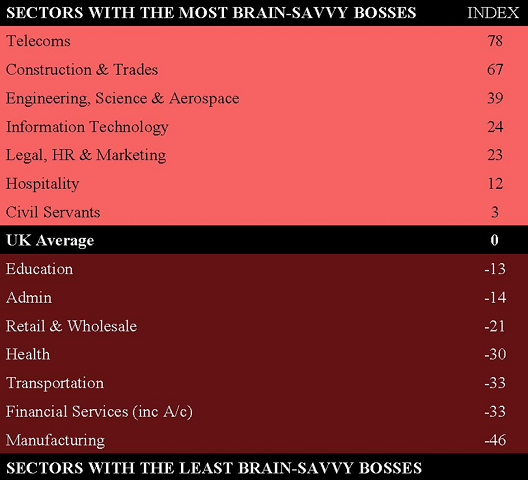If your reaction to my rather controversial title was to want to close the internet page and go do something else you are probably having an avoidance reaction! Your brain experienced the title as a threat. You probably felt you really don’t want to read about this but as a professional you decided to scan the article just in case it goes on to say something useful and the title was just drawing you in. Please read on – you won’t like the data, unless you work in telecoms, but you will find the answer to the issue helpful!
If you saw the title and thought ‘at last someone has the data on what I have suspected for ages’ keep reading but expect to be concerned if you work in Financial Services or Manufacturing.
Despite hard times companies are spending on leadership development. A recent CMI report says they spend between £1400 and £1700 per annum per person in a manager role. But is this money well spent? Clients repeatedly tell us they have sophisticated development programmes, many at high ranking institutions costing much more than the CMI found but they are failing to get changes in behaviour.
We believe them! Why? We have the data.
The Brain-Savvy Index
To gauge the standard of leadership in different industries, Head Heart + Brain commissioned a poll of more than 2,000 people which asked UK workers questions about their bosses based on the key criteria of what makes a good leader. These criteria are derived from the principles of neuroscience, the science of how the brain works. We believe if leaders work in a brain-savvy way, a way that works with the brain rather than against its biological workings, leaders can be more effective and in turn lead people better. The survey measured various factors, from the amount of autonomy employees are given and the clarity and openness of communication about job responsibilities and targets to the quality of feedback and the fairness of leaders. But by far the most important factor the index analysed was how well leaders help employees understand change. More on that in another article for HRZone.
From the responses of people across a number of sectors we created an index. We call it the Brain-Savvy Index and it tells us how different sectors stack up on effective leadership. See below for a summary of the data, then our view on what you can do if your leaders are struggling.
The data
Our survey showed that:
- The telecoms sector has the most brain-savvy leaders
- Leaders in financial services and the accountancy profession are the most brain-fried in the UK
- Manufacturing are a close second on the brain-fried end of the scale
- Leadership in the Civil Service is just above the UK average
- A quarter of leaders in health are failing to manage change correctly and are well below the UK average on the index
- Retail, transport and education are below the UK average in leadership

Of course our survey can’t predict your leaders behaviour; you may be in financial services and thinking ‘actually our leaders are pretty brain-savvy’. Or you may be in telecoms thinking ‘our leaders are definitely brain-fried’ and you may be right. The only way to be sure is to get your employees to complete the brain-savvy index survey and you will know for sure.
The questions we asked people are about how their leaders lead them. The questions cover areas clients tell us they are trying to improve in leadership development and yet employees are not seeing the benefits. The results suggest that some sectors have a crisis of leadership. The surprising thing is these are sectors that we know spend considerable sums on leadership training. So what is going wrong? Why are companies spending on leadership development and still getting poor leadership?
The link with leadership development
Our view is that it’s about the structure and design of their programmes. They are not designed to be compatible with how the brain learns and how behavioural change takes place. No one ever changed their behaviour because they learnt a new model, attended a lecture, or because the CEO told them to change. That is just not how behavioural change happens. The neuroscience of learning and behaviour change is complex with multiple layers. Here is a brief summary of what neuroscience tells us about how individual learning and change happens. You can use it to compare what you do in your development programmes. You may also want to read my article on ‘How understanding neuroscience can increase the ROI on your training investment’
- Insight People change when they have their own insight. Leadership development needs to facilitate insight through experiences, questions and reflection. Far too many programmes impart information.
- What's In It For Me? (WIIFM) People need to work out why the information or behavioural change is important and why changing makes sense to them personally. The WIIFM is critical even if we are generally more subtle about how we describe it.
- Mindset Programmes need to be working on the beliefs and mindset level not just behaviour. In my view too many programmes expect change to happen when people hold the same beliefs as prior to the change. Think about it, did you ever change your behaviour and hold a contradictory belief? The brain is just not structured to be able to do that. To learn you need the leader’s attention. And knowing there is some personal benefit is a sure way of securing it. To apply the learning the leader must believe it makes sense, preferably over the long term.
- Make it personal To learn leaders need to also generate their version of the knowledge. That is to make the insight their own and apply it to their role. You are seeking to create new neural connections. Remember Hebbs law that ‘neurons that wire together fire together’. According to Kevin Oschner 70% of what we do is habitual. If we want leaders to adopt new behaviours the first step is to begin to wire the neurons. This happens when an insight is applied, discussed, written about and goals created.
- Self then others 85% of the areas of the brain that are used to think about yourself are also used to think about others. Unless leaders can apply the learning personally they will find it terribly hard to apply it to others. I spent some time last week with the top 200 leaders of one of the biggest parts of the civil service. They are doing great work on transforming their leadership but still too many people were approaching it as something ‘out there,’ done to others. First it needs to be ‘in here’ part of the leader’s experience. This links to the next point.
- Learn then teach Because other people are important, learning in a social context makes learning sticky. And Matt Lieberman has shown that learning something so that we can teach others makes it stickier still. You can learn more in his recent TED video. This adds an emotional element to the learning and generates personal motivation for the leader. So if you require your leaders to teach others, or pass on their learning to their teams, deliver development in this context and you shift the dial in the right direction.
- Spacing and reflection There is absolutely no point in cramming programmes full of material and giving little or no time for application and reflection. Research at Carnegie Mellon by Alison L. Barth has shown that in the short term, synapses get stronger than previously thought, but then quickly go through a transitional phase where they weaken. Recently strengthened synapses are peculiarly vulnerable and more stimulation can wipe out the effects of prior learning. More training during this phase will undo what was previously learnt. In other research at the same university David Cresswell has found that when people process complex information, giving them time to reflect, if only a few minutes, makes their use of the information more effective and their decisions much better. Do you space out learning with time to reflect and apply to the job?
- Create new habits Finally, personal change must be embedded. Too many programmes stop too quickly before new behaviours have been made into habit. Designing in habit creation is critical to successful development. Habits are run by the basal ganglia, a part of the brain which is energy efficient. To create new habits people must create a cue to tell them when to perform the behaviour, a routine and a reward for doing it. Then persist until they do it automatically. Using social learning platforms to support embedding can be helpful; the community provides both support and a social pressure group.
For a brief animated summary of the brain-savvy criteria you can watch my video.
How do your leadership programmes rate against the brain-savvy criteria? As someone who spent many years working in the financial services industry it pains me to see these results. So if that’s where you work I urge you to make an honest review. And even if you work in one of the more brain-savvy sectors according to the responses in the survey no sector is doing well across all the criteria so in what areas could your programmes improve?






2 responses
Thank you
for your comments. I also agree with the additional points you make. the piece about spacing is really about bit size chunks. people do not realise how fatigues the brain gets and waste a lot of training and development time delivering stuff when people are zoned out. this goes for on job learning too. people must take more breaks to be effective.
Thanks again
Business leadership
An interesting article. I agree with many of the points you make,but from a pragmatic view based on experience rather than from any expertise drawn from brain research, or indeed leadership research of any sort. And I have a few additional angles too.
I especially agree that for leaders to lead a change in the behaviour of others they have first to explore their own behaviour. Behaviours don't change just because the leader says they should.
I also agree on the need to create time to reflect on learning, and I would argue on experience. It's looking back at what has happened, identifying what has gone well and noting why and what has not gone so well and trying to understand why not that enhances the learning.
And so the the two ways in which I'd add to your thinking. Firstly Id' propose that learning from experience (own and others) is as important as learning from programmes. Secondly I believe strongly that learning in bite sized chunks, in our case, for the obvious pragmatic practical reasons, one day at a time, provides the best return on investment. Put simply we are applying the Kaizen, continuous improvement approach that revolutionised manufacturing in the sixties and seventies to training and development. In our case focused on Managing Directors and other business leaders, but equally applicable, I believe, to other roles.
Bob Bradley
http://www.MD2MD.co.uk